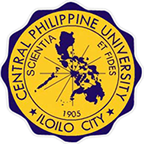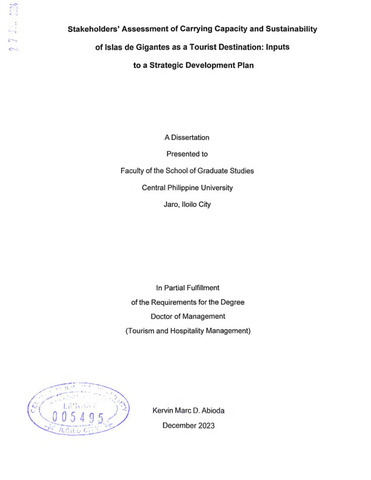Stakeholders' assessment of carrying capacity and sustainability of Islas De Gigantes as a tourist destination: Inputs to a strategic development plan
摘要
This study aimed to determine the carrying capacity and sustainability of Islas de Gigantes as a tourist destination as assessed among the stakeholders and as inputs to a strategic tourism development plan. The study will be conducted in October 2022. This survey-correlational research involved 225 stakeholders of Islas de Gigantes as stakeholders of the study. Using the sectoral representation, as guide, the simple random sampling technique was used in the selection of the stakeholders of the study. Two (2) researcher-made data-gathering instruments was used to gather data needed for the investigation— the Carrying Capacity of Islas de Gigantes as a Tourist Destination Assessment Scale and the Sustainability of Islas de Gigantes as a Tourist Destination Assessment Scale. Obtained data were analyzed using frequency counts, percentage analyses, means, and standard deviations, the t-test for independent samples, the One-way ANOVA, and the Pearson's r. The .05 alpha level was used as the criterion for the acceptance or rejection of the null hypotheses. Study results revealed that, generally, the stakeholders are males, younger, single, and high school graduates. Most are local tourists, government employees, have lower incomes, and represent a non-government organization. Most establishments had average monthly revenue of P 100,000 or less, have 10 or more employees, and have without logistic support, transport provided and LGU support. The stakeholders assessed the carrying capacity of Islas de Gigantes as a tourist destination in terms of physical or ecological carrying capacity, economic carrying capacity, and social carrying capacity, above the desired carrying capacity and the sustainability of Islas de Gigantes as a tourist destination in terms of optimal use of environmental resources, socio-cultural authenticity of host communities, viable long-term economic operations, with extreme sustainability. The stakeholders differed significantly in their assessment of the carrying capacity of Islas de Gigantes as a tourist destination in terms of social carrying capacity when they were classified according to their personal characteristics in terms of civil status, educational background, and sector represented; in their assessment of the carrying capacity of Islas de Gigantes as a tourist destination in terms of economic carrying capacity when they were classified according to island characteristics in terms of average monthly revenue, manpower resources, transport availability, and LGU support; and in their assessment of the carrying capacity of Islas de Gigantes as a tourist destination in terms of physical or ecological carrying capacity when they were classified according to island characteristics in terms of LGU support. They differed significantly in their assessment of sustainability of Islas de Gigantes as a tourist destination in terms of socio-cultural authenticity of host communities and viable long-term economic operations when they were classified according to their characteristics in terms of civil status, educational background and sector represented; in their assessment of the sustainability of Islas de Gigantes as a tourist destination in terms of optimal use of environmental resources when they were classified according to the island characteristics in terms of average monthly revenue, manpower resources, transport availability, and LGU support; and in their assessment of sustainability of Islas de Gigantes as a tourist destination in terms of socio-cultural authenticity of host communities when they were classified according to the island characteristics in terms of manpower resources. Finally, positive and significant relationships existed among stakeholders’ assessment of the carrying capacity of Islas de Gigantes as a tourist destination in terms of physical or ecological carrying capacity, economic carrying capacity, and social carrying capacity and the sustainability of Islas de Gigantes as a tourist destination in terms of optimal use of environmental resources, socio-cultural authenticity of host communities, viable long-term economic operations. A Strategic Development Plan for Islas de Gigantes was prepared by the researcher as an offshoot of the study.
描述
Abstract only
建议引文
Abioda, K. M. D. (2023). Stakeholders' assessment of carrying capacity and sustainability of Islas De Gigantes as a tourist destination: Inputs to a strategic development plan [Unpublished doctoral dissertation]. Central Philippine University.
文件类型
Dissertation主题
部
School of Graduate Studies学位
Doctor of Management (Tourism and Hospitality Management)货架位置
HD 30.37 .A25 2023
物理描述
xii, 159 leaves


